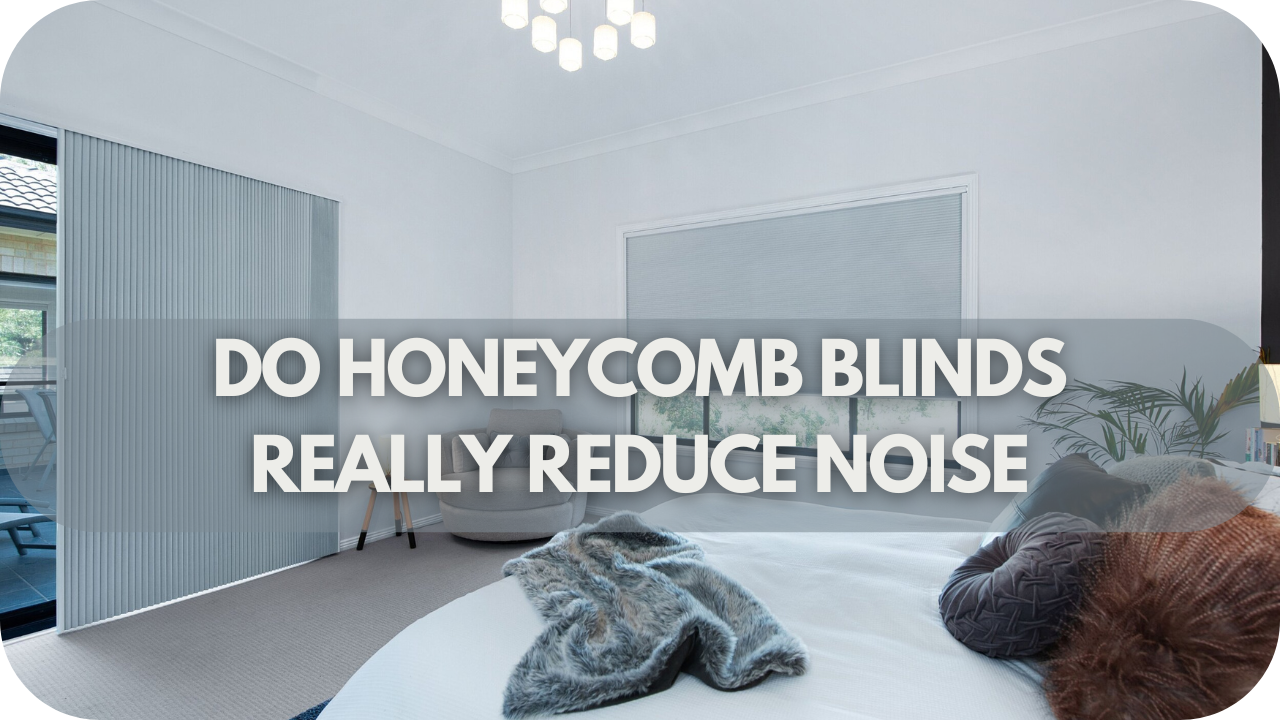I was excited about the large windows and open space when I first moved into my new home. But soon enough, I realised just how much noise from outside would seep into my living room. The constant hum of traffic and neighbourhood chatter became overwhelming.
In my search for a solution, I stumbled upon honeycomb blinds. They promised to reduce noise, but I was sceptical. Could a simple window cover make a difference? It was time to discover if honeycomb blinds truly lived up to their claims.
Do Honeycomb Blinds Really Reduce Noise?
Yes, honeycomb blinds can help reduce noise. Their unique cellular design traps air, creating an insulating barrier that dampens sound from outside. While they won’t eliminate noise, honeycomb blinds significantly reduce sound levels, making them a practical option for quieter indoor spaces. Their noise-reducing ability varies based on the thickness and material of the blinds.
What Are Honeycomb Blinds?
Honeycomb blinds, or cellular shades, are popular window covers designed with functionality and style in mind. Their distinctive structure features a series of hexagonal or honeycomb-shaped cells, which trap air between the layers of fabric. This unique design not only insulates against heat and cold but also helps to dampen noise.
Why are they called honeycomb blinds? The name comes from their shape, resembling the hexagonal cells in a honeycomb. These blinds are available in single, double, and even triple-layered designs, providing varying insulation levels and noise reduction.
In terms of appearance, honeycomb blinds offer a clean and modern look, suiting various interior styles. Made from durable, lightweight materials like polyester, they are easy to maintain and come in a range of colours and textures.
Though often chosen for their energy efficiency, the soundproofing benefits of honeycomb blinds have made them increasingly popular for those seeking a quieter home.
How Honeycomb Blinds Reduce Noise
Honeycomb blinds are designed to block noise by trapping air within their cellular structure. Each cell acts as an insulating pocket, reducing the sound that passes through the window.
As sound waves hit the blinds, the cells absorb and dampen the noise, preventing it from entering the room.
In addition to their insulating qualities, honeycomb blinds are thicker than standard blinds, adding an extra layer of soundproofing. With more cells or layers, the blinds can significantly reduce noise.
Are honeycomb blinds the perfect solution for noisy environments? While they won’t block out all sound, they noticeably reduce outside disturbances, especially in busy areas or homes near traffic. For maximum effectiveness, thicker or double-cell designs are recommended.
Finally, their fit plays a role in noise reduction. Honeycomb blinds that are properly measured and installed will seal the window more effectively, helping to block out noise from outside. These blinds combine style and practicality, making them ideal for anyone seeking a quieter space.
The Extent of Noise Reduction: What to Expect
Honeycomb blinds do reduce noise, but it’s essential to understand the extent of their effectiveness. They won’t create total silence, but they can significantly lower the volume of outside noise.
Soundproofing depends on the thickness and layers of the blinds. Double or triple-layered honeycomb blinds provide better noise reduction than single-layer designs.
Honeycomb blinds can reduce noise levels by around 30 to 50% in busy areas. This makes a noticeable difference, especially in rooms facing traffic, noisy neighbours, or busy streets. The insulating air pockets trap and absorb sound waves, preventing them from entering your home.
Are there limits to their soundproofing capabilities? Yes, loud noises like heavy construction or nearby sirens will still be audible, although less intense. While honeycomb blinds won’t eliminate noise, they offer a comfortable improvement in indoor sound levels.
Consider combining honeycomb blinds with thicker curtains or double-glazed windows to enhance sound reduction. Together, these elements create a more soundproof environment for homes or offices.
Honeycomb Blinds for Different Environments
Honeycomb blinds are renowned for their sound-absorbing qualities. Designed with a unique cellular structure, they trap air within their hexagonal cells, acting as a buffer against external noise.
In bustling city environments, where street sounds can be overwhelming, honeycomb blinds offer a valuable retreat from constant commotion. They can significantly reduce noise infiltration, making your living space more serene.
When installed in home offices, honeycomb blinds can create a quieter workspace, enhancing focus and productivity. They also contribute to a restful bedroom environment by muffling disruptive noises, promoting better sleep quality.
Meanwhile, their energy-efficient design also provides insulation against temperature fluctuations, adding another comfort layer.
Have you considered their versatility in different settings? From reducing echo in large, open spaces to controlling sound in more intimate rooms, honeycomb blinds cater to various needs. As an added benefit, they come in multiple colours and patterns, blending seamlessly with your decor while delivering on their quiet promise.
Benefits Beyond Noise Reduction
Honeycomb blinds offer more than just a quieter environment. Here’s a look at their additional benefits:
- Energy Efficiency: Honeycomb blinds have a unique cellular structure that provides exceptional insulation. This helps maintain a consistent indoor temperature, reducing energy bills by lowering the need for heating and cooling.
- Improved Privacy: With their layered design, these blinds enhance privacy by obstructing views from outside while allowing natural light to filter through. This makes them ideal for ground-floor rooms or homes close to the street.
- Light Control: Honeycomb blinds’ versatility extends to light control. Adjustable options allow you to regulate the amount of light entering your space, creating the perfect ambience for any occasion.
- Aesthetic Appeal: Available in various colours and patterns, honeycomb blinds can complement any interior decor. Their sleek, modern look adds a touch of elegance to your windows.
- Easy Maintenance: Maintaining honeycomb blinds is straightforward. The dust-resistant material can be easily cleaned with a vacuum or a damp cloth, ensuring they stay fresh and new with minimal effort.
Installation Tips for Optimal Noise Reduction
Achieving the best noise reduction with honeycomb blinds involves careful installation. Follow these tips to maximise their effectiveness:
- Fit Closely to the Window: Ensure the blinds are mounted as close to the window as possible. Gaps around the edges can diminish their sound-absorbing properties.
- Seal the Edges: Check for a tight seal around the frame. Any spaces or gaps can allow noise to seep through, reducing overall noise reduction.
- Layer for Extra Insulation: Use honeycomb blinds with heavy drapes or curtains. Layering can provide additional sound insulation.
- Choose the Right Cellular Size: Larger cells can offer better sound absorption. Consult with your supplier to select the size that best suits your needs.
- Ensure a Level Mount: Verify that the blinds are installed level. An uneven mount can affect their noise-reducing performance.
Other Tips for Soundproofing a Room
Honeycomb blinds are a great start, but they’re just one piece of the puzzle. For a truly serene space, consider these additional soundproofing strategies:
- Seal the Gaps: Sound sneaks through cracks and crevices. Use weatherstripping or caulk to seal around windows, doors, and any openings for pipes or wires.
- Add Mass: The heavier the material, the harder it is for sound to penetrate. Consider adding mass-loaded vinyl to walls or ceilings or simply hanging thick curtains or tapestries.
- Decouple the Walls: Sound vibrations travel easily through solid structures. Decoupling creates a break, reducing transmission. This can involve adding resilient channels or sound isolation clips before installing new drywall.
- Absorb the Sound: Soft, porous materials trap sound waves. Add rugs, carpets, upholstered furniture, or acoustic panels to soak up echoes and reverberations.
- Consider White Noise: A white noise machine or fan can help mask unwanted sounds and create a more peaceful atmosphere.
Remember, a combination of approaches often works best. Experiment with different techniques to find the ideal balance for your space and budget.
Conclusion
Thanks to their unique design, honeycomb blinds deliver notable noise reduction, but results can vary. For the best outcome, ensure proper installation and consider combining them with other treatments.
Ready to transform your space? Explore our range of honeycomb blinds and experience the difference in sound quality and comfort today.


